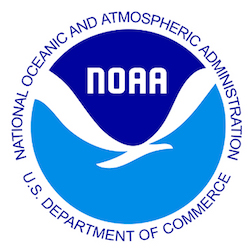SEJournal Online is the digital news magazine of the Society of Environmental Journalists. Learn more about SEJournal Online, including submission, subscription and advertising information.
TipSheet: With NOAA Cuts, Will Trump Starve Climate Messenger?
White House plans to radically limit the budget of the National Oceanic and Atmospheric Administration present a plethora of local, state and regional news for environmental journalists — while also possibly undercutting the many climate stories its work currently generates.
NOAA, housed inside the Commerce Department, is a collection of sub-agencies with air and water duties.
Among them: The National Weather Service, National Hurricane Center, Sea Grant, National Marine Fisheries Service, National Centers for Environmental Information, National Marine Fisheries Service.
Not only that, but NOAA also runs a fleet of Earth-probing satellites, another fleet of research ships and a corps of geographers keeping updated charts of coastal waters.
Oh yes, those scientists who fly airplanes into hurricanes to keep you safe? They are also from NOAA.
In fact, NOAA has a lot of scientists, and the data they collect often bears directly on climate — perhaps the reason the budget office of the Trump administration wants to cut the agency’s total budget by some 17 percent.
Cuts that deep will harm climate research, which depends partly on consistent measurements over long time periods. But it will also undermine programs that benefit people all over the United States.
Marine/coastal research program among those to be eliminated
Sea Grant is a key example. It funds marine and coastal research at some 33 universities on a wide range of topics, most of which have big impact on the economic well-being of coastal communities.
Often, Sea Grant backs studies that support fishing industries, which mean jobs for a particular state.
And while Sea Grant has not been a politically controversial program, some of its research could help coastal communities become more resilient in the face of sea-level rise.
Trump wants to zero out Sea Grant’s budget.
You can find contacts for the Sea Grant program in your state or territory here. Some reporters are already turning the proposed cuts into local stories.
 Doing something about the weather … or not
Doing something about the weather … or not
The National Weather Service, likewise, plays a key role in many communities, whether for remote ranchers or urban commuters. Weather information also feeds the news business (it’s the only story that’s always on the front page somewhere).
The NWS works through some 122 local Weather Forecast Offices (find a list and contacts here).
NOAA knows that what it does about the weather — by observing the Earth’s atmosphere and oceans from a fleet of satellites that are improving all the time — makes forecasts better. Good forecasts, in turn, mean dollars and jobs for farmers and ranchers, electric utilities, transportation companies, recreation and tourism industries, construction and other industries.
But the same satellites that save lives by helping predict prairie blizzards and wildfires also help scientists understand more about climate change. Perhaps that is why satellites come in for one of the biggest Trump cuts to the NOAA budget, some 22 percent.
Improving forecasts on drought, storms, climate
NOAA’s network of satellites and research provides the raw material on which the nation’s extensive private weather forecasting industry depends (think Accuweather and Weather Channel).
One reason forecasts are improving is because of NOAA’s increased skill at predicting how the ocean-atmosphere system works over medium-scale time periods, from a few weeks to a few years.
These breakthroughs have come from understanding of the El Niño-Southern Oscillation, or ENSO cycle, through work centered at NOAA’s Climate Prediction Center. This is what makes drought forecasting better.
Of course, some of us really like knowing when a tornado is headed our way, because loss of life and property matters. And we can, thanks to experts at NOAA’s National Severe Storms Laboratory in Norman, Okla. The NSSL’s work with things like special radars has saved many lives.
And, yes, NOAA does important research related to climate. Examples may be found at NOAA’s National Snow and Ice Data Center in Boulder, Colo. NSIDC tracks glaciers and sea ice that tell a lot about progressing climate change (and provide a steady stream of stories to journalists).
Fortunately for journalists, NOAA has historically run one of the more helpful and transparent press operations. Whether that will continue under Trump remains to be seen. You can still find public information officers to talk to on NOAA’s communications page.
* From the weekly news magazine SEJournal Online, Vol. 2, No. 12. Content from each new issue of SEJournal Online is available to the public via the SEJournal Online main page. Subscribe to the e-newsletter here. And see past issues of the SEJournal archived here.













 Advertisement
Advertisement 



